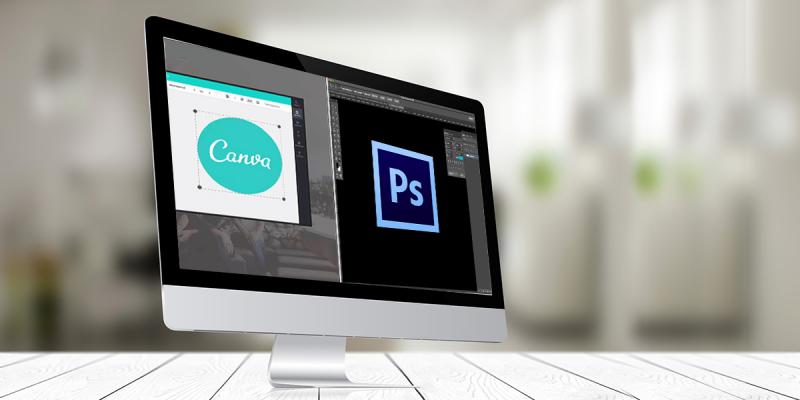Canva vs Photoshop- Which One to Pick?
“Editing is everything. Cut until you can cut no more.” -Esther Freud
Indeed! But hiring a designer can get very expensive. Different graphic designing tools are used for different purposes. People select and use a graphic designing tool or software based on what they need to create. With so many options of graphic designing tools to choose from, it can get quite confusing while choosing which one would be the most suitable.
Today, we are are going to compare two such popular tools- Canvas and Adobe Photoshop.
While Photoshop was created way before Canvas came in existence, Canvas is a relatively easy-to-use and easy-to-setup tool. Let us look at how the two differ, and which one would be more suitable for the graphics and visual content that you’ll need to create and edit.
In Terms of Features
Canvas:
- It is a web-based application
- It doesn’t allow syncing of images to the cloud.
- Photo editing features include photo straightener, image cropper, adding text to photos, speech bubble maker, transparency tools, photo enhancer, photo blur, photo vignette, photo effects, design and photo grids, free icons, photo frames, web wireframe, stickers, badges, and textures, among others.
- Custom fonts and access to branded elements are available for paid version only.
- It doesn’t support transparency functionality.
- It doesn’t give much control over how your images are saved.
Adobe Photoshop:
- It is not a web-based application and requires installation
- Its integrated cloud support service allows syncing of images to the cloud.
- Photo editing features include multiple photos combining, photo retouching, photo effects, removing unwanted objects from photos, changing facial features, photo blurring and object blurring, controlling what should be in focus, creating panoramas, photo sharpening, photo straightening and cropping, adjustment brush, enhancing a photo with text, altering a photo’s perspective, creating photos for social media, improve lighting and color, adding creative effects, custom fonts, camera RAW, Puppet Warp, Content-Aware Scale, layer styles, 3D files (including repousse technique), proof colors, HDR Pro, variables, copy merging, brush tools, smart objects, zoomify, and vibrancy adjusting, among others.
- Custom fonts and access to branded elements are available for free.
- It supports transparency functionality.
- It gives full control over image optimization.
The Pros and Cons
Canvas:
- Pro: It has lots of built-in elements, designs, and dimensions.
- Pro: Extremely easy to figure out and use.
- Pro: No installation is required since it is a web-based application
- Pro: Designed images can be directly shared on social media.
- Pro: There is a large stock of images, templates, graphics, icons, patterns, fonts, layouts, grids, illustrations, and filters
- Con: Limited photo editing capabilities and functionalities
- Con: It is much costlier that Photoshop
- Con: It requires an active internet connection to use this application. If the internet connection is slow, it can take a lot of time to upload and edit visual content.
- Con: It doesn’t have a layers menu, due to which navigation becomes quite difficult.
- Con: It doesn’t give much control over image optimization and doesn’t support transparency.
Adobe Photoshop:
- Pro: Plenty of design tools suitable for the web and mobile responsiveness.
- Pro: Allows editing not just photographs, but videos and other visual content as well.
- Pro: A feature called ‘Actions’ allows you to record and save a series of edits that are applied to an image. So, when you create multiple variations of the same image, you can use this feature to have your finished product ready within minutes. This saves a lot of time.
- Pro: Provides the layers menu, which lets you organize all your stuff into folders for easy navigation
- Pro: It has a swatches menu, which saves all your favorite colors and let you quickly color match anything using the eye dropper tool.
- Pro: Supports both 2D and 3D image designs.
- Pro: New creative cloud lets you save everything on the cloud.
- Pro: Unlimited tools for photo corrections and manipulations
- Pro: Give you lot of control over your image optimization, alignment, fonts-spacing, etc. The integrated stock library ensures that you have more control.
- Con: There are very few pre-made patterns, filters, shapes, etc.
- Con: Interface can be complicated and the learning curve can be quite steep, as it is often difficult for new users to learn to work with it.
- Con: Direct sharing to social media is comparatively difficult.
- Con: It requires high-end models and system configurations.
- Con: Difficult to set up, since it requires installation and a lot of RAM and hard-drive space.
Take Aways
If you want to create and design something quickly and easily, Canvas would be a better option
If you are not a professional and have never used Photoshop earlier, then Canvas is the way to start.
But if you require access to advanced design tools and create complex designs, then Photoshop should be a preferred option.
Content Source : https://goo.gl/7gH2G9
